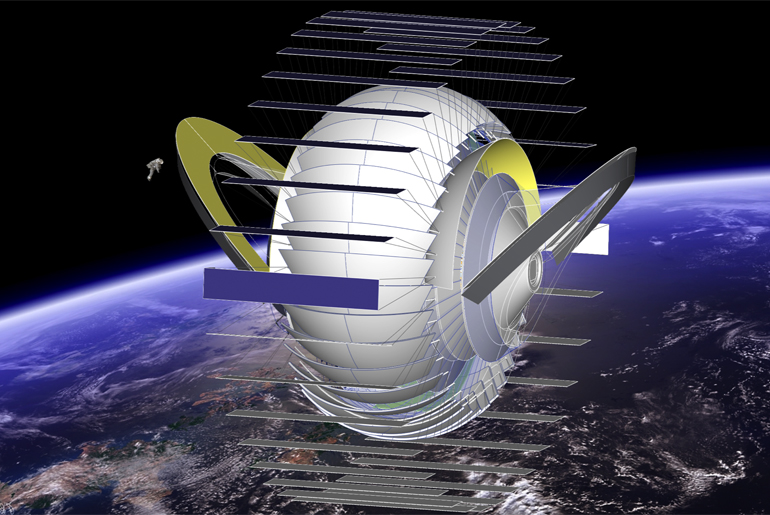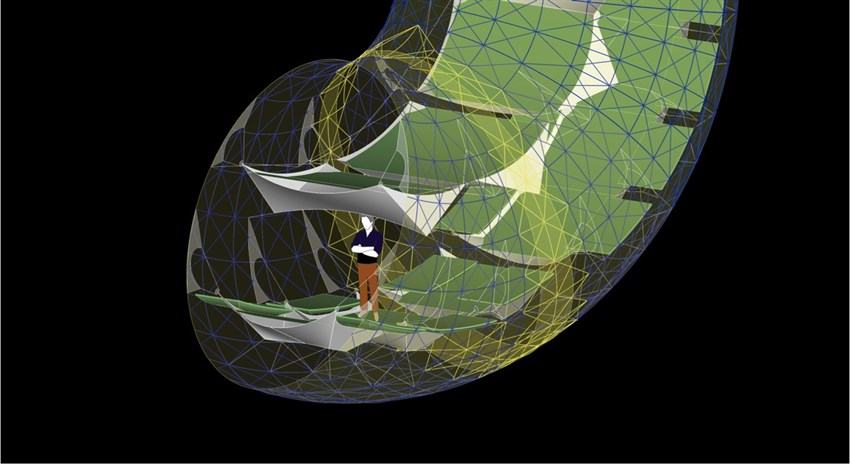
Dr. Robert Skelton, a Texas A&M Engineering Experiment Station (TEES) distinguished professor, helped design control systems for SKYLAB, NASA’s first space station. Now, he hopes to design the next one.
Skelton’s office in the Bright Building on the Texas A&M University campus is littered with structures created out of wood or metal held together with strings that make the room look a bit like a modern art exhibit. The structural paradigm behind them is called tensegrity, an amalgamation of the words tension and integrity. An internet image search of the word will turn up a number of modern art exhibits.
Skelton believes tensegrity structures, which are exceptionally rigid yet lightweight, are the solution to some of the biggest problems NASA faces in long-term space flight. His “Tensegrity Approaches to In-Space Construction of a 1g Growable Habitat” proposal was recently selected by the NASA Innovative Advanced Concepts Program (NIAC) as one of eight proposals to receive as much as $500,000 in funding over the next several years to research feasibility.
“This project is trying to solve four space-related problems,” Skelton said. “First is to figure out how to grow habitats in space. Second is how to solve the gravity problem--how do we give gravity to astronauts? Third is how do you shield and protect them from the galactic radiation that’s in space? Fourth is how to manufacture structures in space?”
Each of the eight NIAC proposals are based on ideas that science doesn’t yet have the technology to implement. Others include deep sleep chambers for astronauts, and using plasma from a planet’s atmosphere instead of heat shields to slow down manned spacecraft. With this second round of funding, the goal is to try and close the gap between the concepts and the technology.
“You see these sticks and strings laying around, well this turns out to be the minimum mass way to build structures,” Skelton said pointing to one of the structures in the office. “So it’s a new structural paradigm, and it’s a new manufacturing paradigm. That’s why it’s on the advanced concepts list. It’s a study about the feasibility for the future. It’s not going to happen overnight. It might not even happen in my lifetime. But these are the steps you have to take.”
What Skelton referred to as “the gravity problem” is an issue NASA hasn’t had to worry much about yet, but would as the length of space travel grows. Astronauts lose bone mass while in space, and while exercise equipment aboard the International Space Station helps slow this process, it doesn’t stop it. That’s just the beginning of the problems faced in a zero-g environment.
“I think NASA is finally realizing the need for a 1g program in the space program,” Skelton said. “There are fundamental questions that we don’t have answers to. What is the gravitational level that’s healthy for human beings? Can you raise children in 1/3g or 1/2g or do you need 1g? We need facilities to study the effects of gravitational environments on the human body.”
To solve this, the structure would spin, creating artificial gravity due to centrifugal force inside. The introduction of gravity into the space program would also help solve another problem, food. With gravity, light and enough space, astronauts could potentially grow crops in space.
A similar problem is radiation. For someone in space to have the same protection from radiation that we experience on the Earth’s surface, they would have to be surrounded by at least two meters of water. The lack of radiation protection hasn’t been a huge issue because of the relative short amount of time spent in space so far.
“This is a totally new thing for NASA,” Skelton said. “They’ve never protected their astronauts from radiation before because they’re up there for a relatively short period of time. But if you want a permanent presence of humans in space, you can’t avoid this problem.”

With his experience working on structures in the past, Skelton said a common problem is the stove piping of ideas. Someone would design a structure, and someone else would design the controls, someone else the navigation systems, and so on. He believes that the future of space flight, and the future of engineering itself, is in finding fundamental new ways to integrate and combine the disciplines. The potential to break down some of those walls is what drew Skelton to Texas A&M in the first place.
“Engineering has left us with a lot of component technologies without rules about how you put components together to make systems,” he said. “So you start at the interface of two disciplines like structure and control design or signal processing and structures. You start at those interfaces and you find better ways to pose the problem. If you want to integrate two disciplines you, can’t start at the state-of-the-art of either one. You have to find more fundamental ways to pose the question.
“It’s not just enough to talk to each other because we don’t know what to say. We don’t have the analytical tools to integrate the disciplines. I think the university that develops them will be the leader in the future of engineering.”
Skelton’s team on the project includes TEES Institute of Engineering Education and Innovation director, and former astronaut, Dr. Bonnie Dunbar; TEES Texas Institute for Advanced Study (TIAS) professor Dr. David Hyland; and Department of Aerospace Engineering associate professor Dr. Raktim Bhattacharya. He’s also working with Anthony Longman, a California-based architect who has proposed his own tensegrity structures to NASA, and Joel Sercel, CEO of ICS Associates.
To bring his proposal into reality, Skelton will have to scale several hurdles. The technology doesn’t yet exist for robots to create tensegrity structures, which is something necessary since, as he says, “We don’t want astronauts out there with bolts and screwdrivers.” Smart manufacturing and robotic technologies are as much a part of the research as the design of the structures themselves.
To start, Skelton said the group will focus on the design of the habitat itself and how it will grow in space. He says the ability to expand the habitat is a key reason why his proposal is of interest to NASA. Despite the many challenges still to come, Skelton said working on something that could help send humans deeper into space than ever before is rewarding.
“For me, it’s satisfying that I’m working on the last space station, at least in my lifetime it will be the last space station,” he said. “I designed control systems on America’s first space station, SKYLAB. So it’s a fun closure for me.”
Images provided by Dr. Robert Skelton
